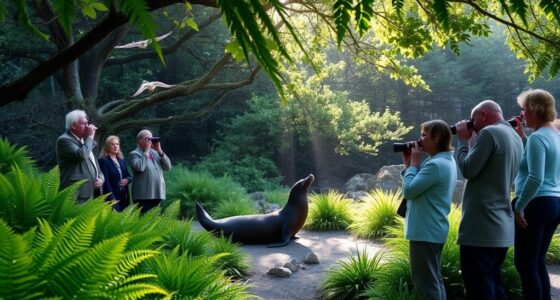When snorkeling and diving in Samoa, it’s essential to practice reef-safe habits. Avoid touching coral or standing on it, as this helps preserve fragile ecosystems. Use mineral-based sunscreens instead of conventional ones to protect coral reefs from harmful chemicals. Consider joining guided tours led by locals who prioritize conservation and can share insights about the underwater world. Embracing these practices ensures a richer experience now and helps safeguard Samoa’s stunning marine life for the future. There’s more to discover about the beauty and responsibility of underwater adventures.
Key Takeaways
- Practice responsible marine practices to protect coral reefs and marine life while enjoying Samoa’s underwater beauty.
- Explore Marine Protected Areas (MPAs) to observe thriving ecosystems and contribute to conservation efforts.
- Avoid touching coral and maintain a respectful distance to prevent harm to fragile marine habitats.
- Use reef-safe sunscreen to avoid harmful chemicals that contribute to coral bleaching and protect marine environments.
- Join guided tours led by local experts to learn about sustainable practices and engage in active conservation efforts.

When you explore the vibrant underwater world of Samoa, you’ll find that practicing reef-safe snorkeling and diving not only protects marine life but also enhances your experience. By choosing to engage in responsible practices, you contribute to coral conservation and help maintain the health of marine ecosystems. The colorful reefs are teeming with life, and by ensuring you act thoughtfully while enjoying this beauty, you play a crucial role in preserving it for future generations.
Practicing reef-safe snorkeling in Samoa not only protects marine life but enriches your underwater adventure for future generations.
Before you jump into the water, it’s essential to familiarize yourself with the local marine protected areas. These zones are designated by conservation authorities to safeguard sensitive habitats and species. When you dive or snorkel in these areas, you’ll witness the incredible biodiversity that thrives when given a chance to flourish. Observing healthy coral reefs and vibrant fish populations not only fills you with awe but also deepens your appreciation for the delicate balance of marine life.
While snorkeling or diving, avoid touching coral or standing on it. Even the gentlest contact can harm these fragile organisms. Instead, glide through the water and maintain a respectful distance. This way, you’ll not only protect the coral but also have a clearer view of the reef’s wonders. Remember that many marine creatures, such as sea turtles and colorful fish, rely on these habitats for survival, and your choices directly affect their wellbeing.
Using reef-safe sunscreen is another important step in your journey toward responsible snorkeling and diving. Many conventional sunscreens contain harmful chemicals that can damage coral reefs and contribute to bleaching. Opt for mineral-based sunscreens that are free of harmful ingredients like oxybenzone and octinoxate. By making this simple switch, you’re actively supporting coral conservation efforts and ensuring that your adventures don’t come at the expense of the marine environment.
Finally, consider joining guided tours or programs that emphasize eco-friendly practices. Local guides often share their knowledge about marine protected areas and the importance of coral conservation. They can help you navigate the underwater world while ensuring you’re following best practices to protect it. Engaging with passionate guides not only enriches your experience but also fosters a deeper understanding of the essential role you play in preserving Samoa’s breathtaking underwater landscape.
Frequently Asked Questions
What Are the Best Times of Year to Snorkel in Samoa?
The best times to snorkel in Samoa are during the dry season, from May to October. You’ll enjoy clearer waters and perfect visibility then. Weather considerations also play a role; avoid the wet season, November to April, when heavy rains can affect your experience. So, plan your trip around those months for ideal snorkeling conditions, and you’ll be sure to see the vibrant marine life Samoa has to offer!
Are There Any Specific Safety Precautions While Snorkeling in Samoa?
When you plunge into Samoa’s azure depths, it’s like entering a living painting. To guarantee your adventure remains safe, always follow local regulations about marine conservation. Wear a wetsuit to protect your skin and avoid touching coral. Swim with a buddy, stay aware of your surroundings, and avoid disturbing marine life. Bringing a reusable water bottle helps reduce waste, letting you enjoy nature while protecting it for future generations.
Can I Rent Snorkeling or Diving Gear in Samoa?
Yes, you can rent snorkeling or diving gear in Samoa. Many local shops offer high-quality equipment, ensuring you have what you need for a safe and enjoyable experience. Before you rent, check the equipment’s condition and ask about any maintenance they’ve performed. It’s important to feel confident in the gear you use. Don’t hesitate to ask staff for recommendations on the best spots to explore while you’re out on the water!
Are There Guided Tours Available for Snorkeling and Diving?
Yes, there are plenty of guided tour options for snorkeling and diving in Samoa. You’ll find various snorkeling tour providers offering experiences that cater to all skill levels. These tours often include equipment rental and knowledgeable guides who’ll enhance your adventure by sharing insights about the marine life. Make sure to book in advance, especially during peak season, to secure your spot and make the most of your underwater exploration!
What Marine Species Can I Expect to See While Snorkeling?
When you plunge into the water, prepare yourself for a spectacular marine reality show! You’ll spot vibrant clownfish darting through anemones, graceful sea turtles gliding by, and maybe even a curious reef shark making an appearance. As you navigate these coral reef ecosystems, remember the importance of marine conservation efforts—your presence helps protect these species. So, while you marvel at nature’s artistry, you’re also playing a role in preserving it.
Conclusion
When you choose reef-safe snorkeling and diving in Samoa, you’re not just having an unforgettable experience; you’re also protecting the stunning marine life. Did you know that about 25% of the world’s marine species depend on coral reefs for their survival? By using eco-friendly practices, you help guarantee these vibrant ecosystems thrive for future generations. So, gear up responsibly and plunge into the beauty of Samoa while making a positive impact on our oceans!










